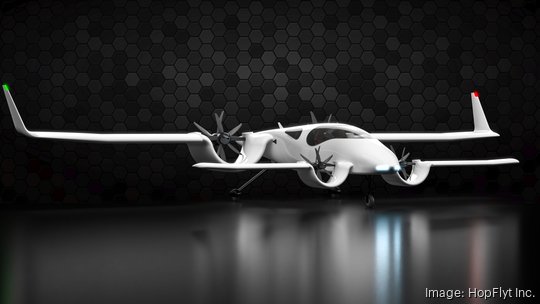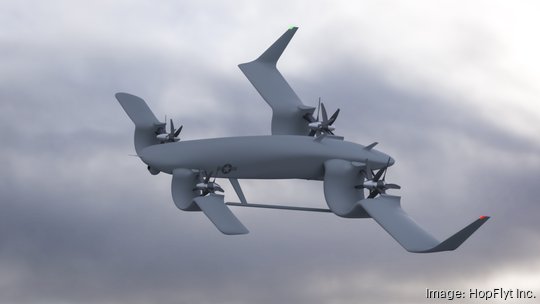
Being based in Maryland and having made an investment in Texas, the husband/wife co-founding team of an aviation/air mobility startup initially never had Paducah, Kentucky, on their collective radar, so to speak.
Then HopFlyt’s Rob and Lucille Winston met Steve Reid, and that all changed about a year ago.
Reid is a native of Paducah who happened to have a mutual connection — a former co-founder whom he had had a successful exit with at CaptureNet, a health care-based, self-pay recovery startup — who had lunch last April with one of HopFlyt’s investors. Reid was intrigued.
“I reached out, had a conversation, trying to understand what their needs were as they were being recruited by other states,” Reid said, “And then I worked with people locally and [throughout] Kentucky, to see what kind of incentives could be cobbled together to attract them to Paducah.”
Before that point, Rob and Lucille Winston had been building the electric vertical take-off and landing (eVTOL) technology that powers HopFlyt’s aspirations in their own personal hangar in the Chesapeake Bay town of Lusby, Maryland, located about 60 miles southeast of downtown Washington D.C.
In search of more space
Rob is a retired lieutenant colonel in the U.S. Marines who has been a pilot for approximately 35 years, including several years serving as a test pilot. Lucille is a former NASA test engineer.
They simply needed more space and less restrictions — both physical and otherwise — to get their company moving in the desired direction of creating several models of electric aircraft for both military and civilian use.
Whereas HopFlyt will be creating two of its three prototypes for current and future military contracts at a facility in Amarillo, Texas, the civilian arm of its operations will be housed in a 5,000-square-foot area of Paducah’s Barkley Regional Airport, per an agreement signed in February between the company, city, airport and McCracken County — with the understanding that HopFlyt’s venue could grow to keep up with overall growth and production needs of the company.

“It’s an amazing place, and it meets a lot of the a lot of the factors that we're looking for. They’ve got a nice regional airport. They’ve got a good industrial base, workers [and a] low cost of living … We found all the right elements,” Rob said.
Luicille later noted the collaborations that would be possible by partnering with the faculty and students at the Paducah campus of the University of Kentucky’s College of Engineering — as well as the college’s Lexington campus.
Reid, who was recently named the CFO of HopFlyt, said the startup is "actively working" with airport's executive director, Dennis Rouleau, on the needed renovations to accommodate the specifications requested by his company. The renovations should take approximately three to four months.
“They were looking for something more open, more friendly to a startup like this,” added Reid, also serves on the board of Sprocket, the Paducah-based tech economic development organization that has helped bring in several other startups to the city, such as Feedcoyote (our recent Inno Madness champion) and Ewagers.
The Winstons are currently residing in Amarillo, but hope to eventually be able to split time between there and Paducah.
“Every time we go there, we get such a warm welcome,” Rob said.

Lifting off
HopFlyt officially filed its first paperwork as a company in 2017, but Rob said that he first had the flicker of an idea about 15 years ago while serving as a Marine Corps pilot of having a vehicle that could hover like a helicopter, but be as fast as an airplane. He looked at various types of motors, but did not start looking at the technologies that would cement their vision until 2014.
Two years later in 2016, well before the term “urban air mobility” had been coined, Rob came to the realization that the technology they were conjuring could work just as well in the civilian market as it could in the military market.
“We’ve realized there’s a real market for this because of the efficiency of the aircraft,” Rob said.
HopFlyt, which was founded as a C-corporation with private investors, is about to kick off a Series A in which it is looking to raise $30 million primarily to create two “man-sized” prototypes of one of their aircraft, the Venturi — and get them through testing. With a wingspan of 53 feet and a length of 43 feet from nose to tail, the Venturi can seat up to five passengers, making it ideal for commercial use.
At this time, its only Kentucky-based investors are Keyhorse Capital. Although the company is open to all investors, Reid said that venture capitalists with ties to aviation and aeronautics will be “likely targets for us.”

HopFlyt’s efforts in Texas — mostly building and testing the smaller-sized Squall (10-foot wingspan) and Cyclone (20-foot wingspan) for intelligence, reconnaissance and surveillance purposes — are largely being funded by a $1 million investment from Albers Aerospace, of which Rob serves as executive vice president for innovative technologies to promote the startup's technology to the U.S. Department of Defense (DoD). Albers is the company's strategic partner — and DoD license holder of HopFlyt's technology — which also has $5 million term sheet (services and manufacturing, in exchange for equity) with HopFlyt.
The Squall will be the first model to go into production, followed by the Cyclone. Thus far, the startup has worked on three military contracts, with two more in the works.
The aircrafts will be “highly autonomous,” according to Rob, which could one day convince the Federal Aviation Administration (FAA) to come with a new license for the aircraft that would be different from the standard rotorcraft (helicopters) and fixed-wing (airplanes) licenses. The plan is to be given a special airworthiness certificate from the FAA, which will allow them to test the newly built aircraft in three years.
“Really the pilot role is going to morph from being a stick-and-rudder guy to a systems operator — the person who can talk on the radio and see other traffic,” Rob said.
HopFlyt currently has 15 employees, with plans to expand its footprint in Kentucky this summer.






